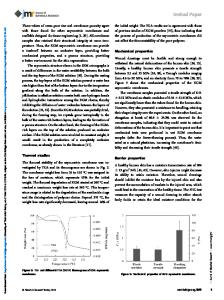Electrospun fibers for tissue engineering, drug delivery, and wound dressing
- PDF / 1,203,441 Bytes
- 28 Pages / 595.276 x 790.866 pts Page_size
- 89 Downloads / 342 Views
REVIEW
Electrospun fibers for tissue engineering, drug delivery, and wound dressing Yi-Fan Goh • Imran Shakir • Rafaqat Hussain
Received: 28 August 2012 / Accepted: 7 January 2013 / Published online: 24 January 2013 Ó Springer Science+Business Media New York 2013
Abstract Electrospinning, a technique well known for fabricating nanoscale fibers, has recently been studied extensively due to its various advantages such as high surface-to-volume ratio, tunable porosity, and ease of surface functionalization. The resulting fibers are extremely useful for applications in the fields of tissue engineering, drug delivery, and wound dressing. Since electrospun fiber mimic extracellular matrix of tissue in terms of scale and morphology, its potential to be used as scaffold is continuously explored by researchers, especially in the field of vascular, nerve, bone, and tendon/ligament tissue engineering. Besides morphology, physical, and chemical properties, electrospun scaffolds are often evaluated through various cell studies. Researchers have adopted approaches such as surface modification and drug loading to enhance the property and function of scaffold. This review gives an overview of some current aspects of various applications of electrospun fibers, particularly in biomedical fields, how researchers have enhanced electrospun fibers with different methods and attempted to overcome the inherent limitation of electrospinning by using novel techniques.
Y.-F. Goh Department of Chemistry, Faculty of Science, Universiti Teknologi Malaysia, 81310 Skudai, Johor, Malaysia I. Shakir Department of Sustainable Energy, King Saud University, Riyadh, Saudi Arabia R. Hussain (&) Ibnusina Institute for fundamental Sciences, Universiti Teknologi Malaysia, 81310 Skudai, Johor, Malaysia e-mail: [email protected]
Introduction Electrospinning, a process utilizing electrostatic forces to fabricate fibers, has been known since 1897 when the principle was first reported by Rayleigh [1], who first reported the electric charge of a liquid droplet required to eject the droplet to form smaller droplets. The first developmental milestone in electrospinning was achieved when Formhals patented the process in 1934 [2]. In 1966, a patent (Patent Number: 3280229) was granted to Simon [3] for producing patterned nonwoven fabrics using electrostatic force. Another milestone was the charged jet forming process discovered by Taylor in 1969 [4]. Numerous research groups have published work on electrospinning in the period 1970–1996, either exploring potential application or studying the electrospinning process itself [5–9]. The setup of electrospinning and the electrospinning process have recently been well discussed [10–13]. The three basic components of the electrospinning setup are high voltage DC power supply, syringe pump and grounded collector (Fig. 1). The syringe pump is used to force the solution or melt through a needle attached to the syringe with a controlled flow rate. When the high voltage is applied to the solution or melt, it induces a
Data Loading...











